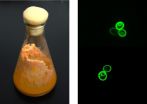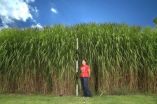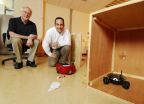(Press-News.org) University of California, Berkeley, researchers have taken genes from grass-eating fungi and stuffed them into yeast, creating strains that produce alcohol from tough plant material – cellulose – that normal yeast can't digest.
The feat could be a boon for the biofuels industry, which is struggling to make cellulosic ethanol – ethanol from plant fiber, not just cornstarch or sugar – economically feasible.
"By adding these genes to yeast, we have created strains that grow better on plant material than does wild yeast, which eats only glucose or sucrose," said Jamie Cate, UC Berkeley associate professor of molecular and cell biology and faculty scientist at Lawrence Berkeley National Laboratory (LBNL). "This improvement over the wild organism is a proof-of-principle that allows us to take the technology to the next level, with the goal of engineering yeast that can digest and ferment plant material in one pot."
The researchers hope to insert the same fungal genes into industrial yeast that now is used to turn sugar into ethanol biofuel in order to improve the efficiency of the fermentation process.
"The use of these cellodextrin transporters is not limited to yeast that makes ethanol," Cate said. "They could be used in any yeast that's been engineered to make, for example, other alcohols or jet fuel substitutes."
Cate and his UC Berkeley and LBNL colleagues, including first author Jonathan M. Galazka, a UC Berkeley graduate student, report their success this week in the journal Science Express. The work is funded by the Energy Biosciences Institute (EBI), a research collaboration between UC Berkeley, the University of Illinois, LBNL and the funding sponsor, BP.
Currently, the biofuel industry employs brewer's yeast, the single-celled fungus Saccharomyces cerevisiae, to convert sugar, cornstarch or other simple carbohydrates into ethanol by fermentation. But plants contain sugar polymers that yeast cannot eat – in particular, cellulose, a tough molecule composed of glucose molecules linked together in long chains. The biofuels industry is now building demonstration plants that will use "cellulosic" sources such as corn stalks, leaves and cobs, paper waste and other plant material to make ethanol.
But cellulosic processes are complex and expensive, Cate said. The plant material must first be broken down into sugars through a process called saccharification. Enzymes called cellulases are added to convert cellulose to short-chain sugars, called cellodextrins, and these must be further broken down into glucose molecules by the enzyme beta-glucosidase. Only then can yeast work its magic and turn the glucose into alcohol.
Other fungi, however, can digest cellulose, though they don't produce alcohol. One of these, Neurospora crassa, a common fungus whose preferred diet is fire-damaged plants, has been studied in the laboratory for more than 100 years, Cate said.
Last year, Chaoguang Tian, a former UC Berkeley post-doctoral fellow in Professor Louise Glass's laboratory who now is at the Tianjin Institute of Industrial Biotechnology in China, and William T. Beeson, a graduate student in UC Berkeley's College of Chemistry, along with Cate and other UC Berkeley researchers, conducted a genome-wide analysis of Neurospora crassa to locate genes that are turned on when the fungus grows on cellulose.
The genome-wide systems analysis turned up a family of genes which produces proteins that transport sugars into the Neurospora cell to be used as fuel. The researchers suspected that some of these transporters would allow Neurospora to import cellodextrins – in particular, the two-, three- and four-glucose molecules (cellobiose, cellotriose and cellotetraose, respectively). A search through the genomes of other fungi that grow on plants turned up similar genes in many of them, including the black truffle, which is symbiotic on tree roots.
Thanks to previous work funded by the National Institutes of Health, the team easily obtained Neurospora "knock-out" strains missing specific transporter genes and confirmed that, without all of them, the fungus could no longer eat cellodextrins as quickly.
"Most sugar-transporters let one sugar in at a time," Galazka said. "The sugar-transporters we found in Neurospora actually let in an entire chain of sugars. This means that four sugars can enter the fungus at once, if they are linked together.
Galazka subsequently created six strains of yeast, each with one extra gene from the Neurospora transporter family, along with a beta-glucosidase gene, also from Neurospora. The yeast strains produced Neurospora transporter proteins, and two of the strains were able to grow on cellodextrin as well as on glucose. One strain produced 60 percent more alcohol than normal yeast when grown on the two-glucose molecule, cellobiose.
Apparently, Galazka said, while normal yeast can't import cellodextrins or digest them once they're inside the cell, if they are given a Neurospora transporter and a beta-glucosidase from the fungus that stays inside the cells, it's able to do both.
"We've effectively made yeast more compatible with the enzymes used to break down woody plants," he said. "We think that the discovery of these transporters is a key step towards the efficient conversion of plant matter now considered waste into fuel."
"We now have to get these genes into industrial yeast strains – the hearty, rock 'em, sock 'em yeast used commercially – and get them to use more complicated plant material," Cate said.
He noted that a cellulosic process using yeast with transporter proteins could avoid having to add beta-glucosidases to the fermentation chamber, but enzymes would still be needed to break down cellulose into cellodextrins.
He and his colleagues are now collaborating with other EBI researchers to create improved transporter proteins and yeast strains.
INFORMATION:
The Science Express paper was authored by Galazka, Tian, Beeson and Cate, as well as by Neurospora expert N. Louise Glass, UC Berkeley professor of plant and microbial biology, and Bruno Martinez of LBNL's Physical Sciences Division.
Researchers expand yeast's sugary diet to include plant fiber
Engineered yeast strains digest cellodextrins as well as glucose
2010-09-09
ELSE PRESS RELEASES FROM THIS DATE:
Greener pastures and better breeds could reduce carbon 'hoofprint'
2010-09-09
NAIROBI (9 September 2010)—Greenhouse gas emissions caused by livestock operations in tropical countries—a major contributor to climate change—could be cut significantly by changing diets and breeds and improving degraded lands, according to a new study published this week in the U.S. Proceedings of the National Academy of Sciences. And as an added bonus, scientists found the small changes in production practices could provide a big payoff by providing poor farmers with up to US$1.3 billion annually in payments for carbon offsets.
"These technologically straightforward ...
Phoenix Mars Lander finds surprises about red planet's watery past
2010-09-09
Liquid water has interacted with the Martian surface throughout Mars' history, measurements by NASA's Phoenix Mars Lander suggest.
The findings, published in the Sept. 10 issue of the journal Science, also suggest that liquid water has primarily existed at temperatures near freezing, implying hydrothermal systems similar to Yellowstone's hot springs on Earth have been rare on Mars throughout its history.
These surprising results come from measurements Phoenix made in 2008 of stable isotopes of carbon and oxygen in the carbon dioxide of the Martian atmosphere. Isotopes ...
The pros and cons of Miscanthus -- uses more water, leaches less nitrogen
2010-09-09
URBANA – In the search for the perfect crop for biofuel production, Miscanthus has become the darling to many. But in an effort to not be charmed by its enormous potential for biomass production, researchers at the University of Illinois are taking a careful look at the pros and cons of its behavior in the field.
A recent study analyzed water quantity and quality in plots of Miscanthus, switchgrass, corn, and soybeans and found that Miscanthus used substantially more water, but reduced the potential for nitrogen pollution to water bodies.
"We found that Miscanthus ...
Researchers give robots the capability for deceptive behavior
2010-09-09
A robot deceives an enemy soldier by creating a false trail and hiding so that it will not be caught. While this sounds like a scene from one of the Terminator movies, it's actually the scenario of an experiment conducted by researchers at the Georgia Institute of Technology as part of what is believed to be the first detailed examination of robot deception.
"We have developed algorithms that allow a robot to determine whether it should deceive a human or other intelligent machine and we have designed techniques that help the robot select the best deceptive strategy to ...
Overweight and obese make up majority in Ontario
2010-09-09
OTTAWA – September 9, 2010 --- New analysis of a landmark health survey by the University of Ottawa Heart Institute (UOHI) shows that 70% of Ontario adults are either overweight or obese, and have a strong prevalence of high blood pressure that could lead to heart attack or stroke.
The research, led by Dr. Frans Leenen of the Heart Institute's Hypertension Unit, adds new information to a limited amount of Canadian data on obesity and high blood pressure. The analysis further strengthens the link between high blood pressure and above normal Body Mass Index (BMI), a formula ...
People learn new information more effectively when brain activity is consistent, research shows
2010-09-09
AUSTIN, Texas—People are more likely to remember specific information such as faces or words if the pattern of activity in their brain is similar each time they study that information, according to new research from a University of Texas at Austin psychologist and his colleagues.
The findings by Russell Poldrack, published online today in the journal Science, challenge psychologists' long-held belief that people retain information more effectively when they study it several times under different contexts and, thus, give their brains multiple cues to remember it.
"This ...
Study says shortage of FSC wood statewide could lead to price premium for green construction
2010-09-09
It's no secret: the United States is in the thick of a "green trend." Increased awareness of and commitment to sustainability and improving the environment through reduced carbon emissions and energy use have led to more consumer demand for "green" products, including green construction. Even with the downturn in the housing market, a 2008 poll showed that 91 percent of registered voters nationwide would still pay more for a house if that meant a reduced impact on the environment.
The same is true for the commercial building industry, as construction companies prioritize ...
Keeping stem cells from changing fates
2010-09-09
Johns Hopkins researchers have determined why certain stem cells are able to stay stem cells.
The report in the June 4 issue of Cell Stem Cell reveals that an enzyme that changes the way DNA is packaged in cells allows specific genes to be turned on and off, thereby preventing a stem cell from becoming another cell type.
Each cell has to fit in 6 feet of highly organized and carefully packaged DNA. Some regions of the DNA are more tightly compacted than others and this structure is dynamic. There are specific enzymes that change how condensed the DNA is to help turn ...
Child's 'mental number line' affects memory for numbers
2010-09-09
As children in Western cultures grow, they learn to place numbers on a mental number line, with smaller numbers to the left and spaced further apart than the larger numbers on the right. Then the number line changes to become more linear, with small and large numbers the same distance apart. Children whose number line has made this change are better at remembering numbers, according to a new study published in Psychological Science, a journal of the Association for Psychological Science.
Remembering numbers is an important skill—in life, which is full of social security ...
Research and insights on severe asthma in children
2010-09-09
New Rochelle, NY, September 9, 2010—A subset of children with asthma suffers from severe, treatment-resistant disease associated with more illness and greater allergic hypersensitivity, according to the results of the National Heart, Blood, and Lung Institute's Severe Asthma Research Program (SARP), presented in a recently published article in Pediatric Allergy, Immunology, and Pulmonology, a peer-reviewed journal published by Mary Ann Liebert, Inc. (www.liebertpub.com). The article is available free online at www.liebertpub.com/pai
Asthma is the most common chronic lung ...
LAST 30 PRESS RELEASES:
Post-stroke injection protects the brain in preclinical study
Cardiovascular risk score predicts multiple eye diseases
Health: estimated one in ten British adults used or interested in GLP-1 medications for weight loss
Exercise to treat depression yields similar results to therapy
Whooping cough vaccination for pregnant women strengthens babies’ immune system
Dramatic decline in new cases of orphanhood in Uganda driven by HIV treatment and prevention programs
Stopping weight loss drugs linked to weight regain and reversal of heart health markers
Higher intake of food preservatives linked to increased cancer risk
Mass General Brigham–developed cholera vaccine completes phase 1 trial
First experimental validation of a “150-year-old chemical common sense” direct visualization of the molecular structural changes in the ultrafast anthracene [4+4] photocycloaddition reaction
Lack of support for people on weight loss drugs leaves them vulnerable to nutritional deficiencies, say experts
Dogs’ dinners can have greater climate impact than owners’
Are you ready to swap salmon for sprats and sardines?
1.6 million UK adults used weight loss drugs in past year
American College of Cardiology comments on new dietary guidelines for Americans
American Society of Gene & Cell Therapy and Orphan Therapeutics Accelerator partner to advance and commercialize promising rare disease treatments
One in 14 patients having day case surgery have new or worse chronic pain 3 months after their operation
New study highlights link between eviction rates and gun violence
Heatwaves heat up soil but not toxin levels in rice, study finds
Digital modeling reveals where construction carbon emissions really come from
Turning farm waste into water filters
New study shows how the spleen helps the immune system accept a transplant
New Mayo Clinic study advances personalized prostate cancer education with an EHR-integrated AI agent
Researchers identify novel therapeutic target to improve recovery after nerve injury
Microbes in breast milk help populate infant gut microbiomes
Reprogramming immunity to rewrite the story of Type 1 diabetes
New tool narrows the search for ideal material structures
Artificial saliva containing sugarcane protein helps protect the teeth of patients with head and neck cancer
Understanding the role of linear ubiquitination in T-tubule biogenesis
Researchers identify urban atmosphere as primary reservoir of microplastics
[Press-News.org] Researchers expand yeast's sugary diet to include plant fiberEngineered yeast strains digest cellodextrins as well as glucose



